
Friendship Highway
 Friendship Highway |
On the other side the real China awaits us. Severe looking soldiers standing at attention salute us through and show us the way with rapid hand movements. No greeting, no smile, no welcome. Our Tibetan guide awaits us with countless permits.
 Gateway to Tibet |
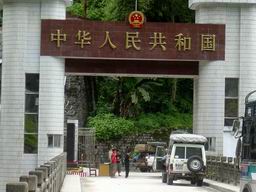 Chinese Border |
The main checkpoint is eight kilometers further. Our papers are sternly checked. And just as we should have expected - we don´t have the Chinese insurance confirmation for the land cruiser. Long negotiations and an eternal wait are imminent. Our guide telephones Lhasa and tries to clear the situation. After we show our English version of the papers, the oh-so-strict border police suddenly come up with a solution. We sign a Chinese declaration, which presumably contains a commitment to drive safely and considerately in China. Other than that we are ordered to get a medical driving capability check-up in Lhasa that can be sent in afterwards. The rest is quickly settled and the Chinese license plate is mounted. At the border crossing two soldiers salute us again as we drive by. We made it. We are in Tibet! Chinese universal time applies here as in all of Tibet. We put our clocks 2 ¼ hours ahead and are lucky that we have still a little bit of daylight left since the state regulated time in this part of China doesn´t really have anything to do with the actual sunrise and sundown. On the other side of the border traders, moneychangers, beggars and the curious await us. We hurry so that we get out of here fast and drive the 60 more kilometers to Nyalam at an altitude of 3,750 meters. The green valley has suddenly changed into a desert-like landscape with an impressive vastness. We are happy about this glorious view that already surpasses all of our expectations.
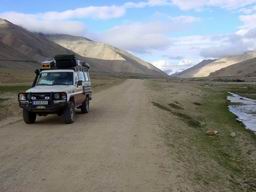 Tibet landscape |
 Thang La |
On the other side the real China awaits us. Severe looking soldiers standing at attention salute us through and show us the way with rapid hand movements. No greeting, no smile, no welcome. Our Tibetan guide awaits us with countless permits.
We go on to Tingri (4,340 meters), where we follow a trekking trail destination Rongbuk and the Everest Base Camp (north side). The following 100 kilometers of trail are real hard. Every owner of a 4-wheel drive vehicle in Europe would go green with envy. The small difference in Tibet is that the closest help in an emergency would be about a three-day hike away. The satellite phone in our pocket is a real relief. In Rongbuk (4,920 meters) we spend a short and sleepless night because of the altitude. In the morning we drive to Everest Base Camp (5,040 meters) and take a hitchhiker from Mexico with us who had just climbed Mount Everest and tells us along the way about his experiences on the mountain. What a difference to the Nepalese side of Everest where we had to trek for two weeks to get to Base Camp. The view of the „undeveloped„ north side of Everest is gargantuan.
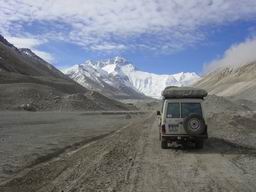 The way to Everest |
 Everest Base Camp |
We go on over the Pang La (5,150 meters) to Shigatse (3,860 meters). Here we experience a real „infrastructure shock„. A modern city with wide, clean streets and even stoplights has been planted in the middle of the Tibetan highland. What a contrast to the other regions. Everything looks conspicuously Chinese. We find accommodations in a first-class hotel and enjoy the amenities of civilization (showers, real toilets).
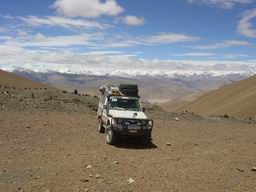 Pang La |
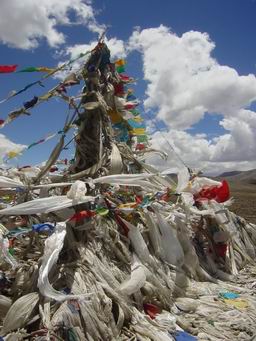 Prayer flags at PangLa |
The next morning a kilometer-long children´s parade barricades our departure. In China it is Children´s Day and all the school children are marching in rows down the street to the beat of a Chinese teacher´s whistle. Somehow these images seem to remind us of those out of the old eastern part of Germany.
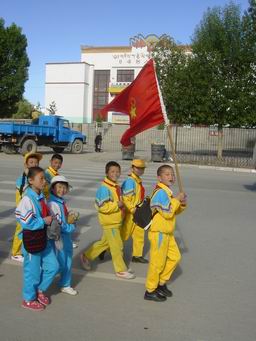 Children´s parade in Shigatze |
 Modern Shigatse |
From Shigatse we follow a well-built road to Lhasa (3,680 meters). Asphalt under the tires never felt so good! We´re already excited about the many sights in Lhasa.
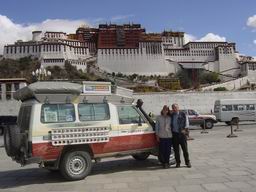 Arriving in Lhasa |
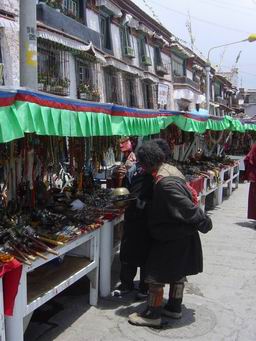 Old inner town of Lhasa |
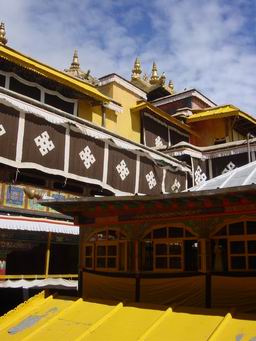 The roof of Potala |
 Pilgrims in front of the Jokhang |
In the meantime we have received our Chinese driving licenses. But not before we had to get a doctor´s check-up in the military hospital.
 Check-up 1 |
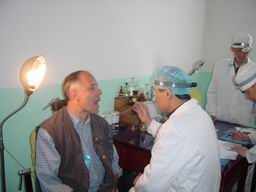 Check-up 2 |
Now we are going again to West Tibet. We will be going 3,000 kilometers and we are very excited about the holy Mount Kailash and the way to Kashgar. We will be able to report again in about two weeks.
Our first day´s drive takes us to Shigatse. We pass the wonderfully beautiful Yamdrok Tso (4,488 meters), also called Scorpion Lake on account of its unique form. We drive on the Karo-la Pass at an altitude of 5,050 meters and stand unexpectedly directly at the glacier fracture of Mount Nojin (7,191 meters). What a view full of contrasts! It seems we´ve climbed the mountain with the land cruiser.
 Yamdrok Yamtso 4,482 meters |
 At the glacier |
After 250 kilometers we reach Gyantse, an ancient trade junction between India and Nepal. There we find the very beautiful Pelkor Choeded Monastery with the imposing Kumbum Chorten, where by way of exception all Tibetan cults can be found under this one roof.
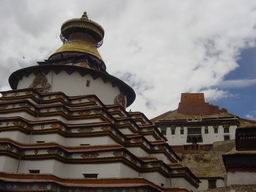 Kumbum Chorten |
The last 80 kilometers go over a horrible stone dam through a flood area to Shigatse. Every few kilometers we are bothered by locals who, with a temporary roadblock, demand a road toll. We can´t get away from the dam.
In Shigatse we visit the huge monastery city of Tashilunpo, the former seat of the tenth Panchen Lama who died suddenly in 1989.
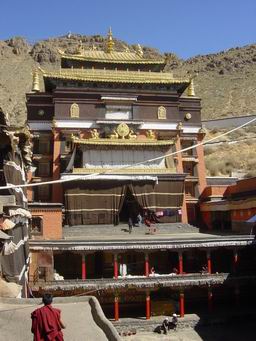 Shigatse Monastery |
 Shigatse Monastery 2 |
We go „only„ another 130 kilometers over bone shattering stone road to Lhatse. One of our almost new tires is literally punctured by a sharp stone and is junkyard material. We ask ourselves if the spare tire for the coming 2,500 kilometers will suffice. Conclusion? Grin and bear it!
During our next tour we are constantly surprised by the varied and changeable landscape of Tibet. We had not imagined it like this. Rugged mountain landscape changes into wide-open meadows with innumerable yak herds and roaming nomads.
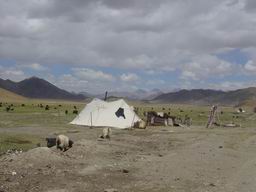 Meadow landscape |
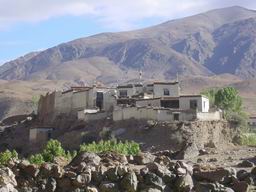 Village |
Again and again we pass abandoned or ruined monasteries.
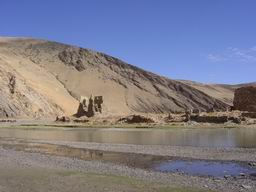 Monastery ruins |
Getting to Saga we have to go over a few passes at a 4,800 to 5,200-meter altitude. Saga is itself an ugly place with Chinese functional architecture. Most importantly is the gas station there where we can hoard our diesel fuel for the next more than 1,200 kilometers. What doesn´t fit in the tank we fill in plastic canisters and bind them to the sides of the vehicle. Better safe than sorry! After all we use up to 20 liters of diesel per 100 kilometers in this difficult terrain.
With accommodations we have unfortunately no luck. All the usual guesthouses are booked. We land in the guest rooms of a brothel and are luckily too tired to find the nightly festivities in the front room as a disturbance. On the next morning we stumble over some soldiers and „floozies„ and flee.
Much to our amazement after Saga the landscape changes into a sandy desert, reminding us of the Sahara but with a difference: that we are about 5,000 meters high and the snow frames the dunes covered mountains of the Himalayas. Absolutely gorgeous! Now and again we are able to wash the dust off the land cruiser crossing through deep water.
 High desert 1 |
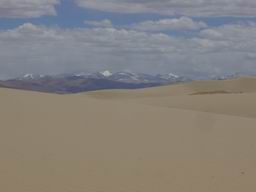 High desert 2 |
 Soft trails |
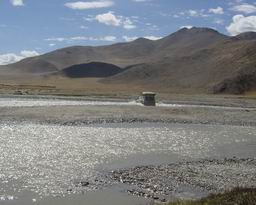 Crossing through deep water |
After a dusty five days we reach Darhen, a starting point for many pilgrims who will circle the holy Kailash. During pilgrimage season the place consists of more tents than houses. We hire someone to look after our vehicle and go by foot this time to Kailash.
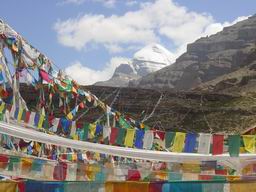 Holiest Kailash 6,714 meters |
 Prostration |
Equipped with tent, sleeping bag, warm clothing and trekking food, we start at Darchen (4,670 meters) and reach Dira Phug (5,060 meters) after six hours, where we set up camp with a view of the Kailash.
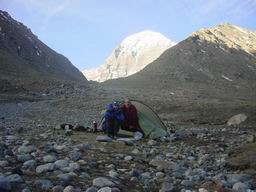 Camping at the mountain |
Everything is holy or has a religious background at the Kailash: the rivers, lakes and waterfalls, the surrounding mountains as well as the stones with hand and footprints. There are no regular tourist system, no protective huts, no cola and snack shops like at the many Nepalese trekking regions. We see few tourists at Kailash and feel absolutely obvious with our colorful high-tech equipment next to the modestly equipped pilgrims.
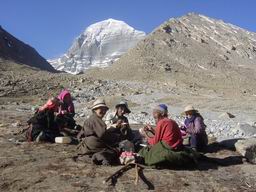 Pilgrim´s break |
On the second day of our trek we have to climb over the 5,670-meter high Doelma Pass. At Shiva Tsal we get the feeling we´re standing in the middle of emptied-out recycled clothes sacks. Believers leave behind clothes, shoes or strands of hair here. In order to reincarnate one must leave something from this life behind. We can´t part with any of our equipment and keep going. We set up our second camp near a nomad settlement where many children suddenly surround us. These small ones are so dirty and shaggy that we can´t imagine how much water and soap would be necessary to clean these kids and their clothes.
Today we have a celebration because we have completed part one of our adventure. At 5,200 meters we celebrate with trekking-carrot casserole and fruit tea. The next morning it is icy cold and we don´t feel like crawling out of our warm sleeping bags. Breakfast is sparse because we forgot our muesli at the first camp. So we have hot milk.
On the way back to Darchen we give the donation from the Nepalese auto mechanics from Katmandu to the Zutrul Puk Monastery. Many believers who can´t come to Kailash themselves give pieces of clothing or donations for other pilgrims to take for them. The „poor„ circle the Kailash for payment.
South of Kailash lies the highest altitude sweet water lakes in the world: the Manasarovar (4,558 meters) and the Rakastal (4,543 meters). We stay two days in order to replenish our energy.
 Pilger |
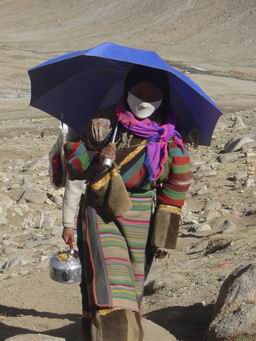 Pilgerin |
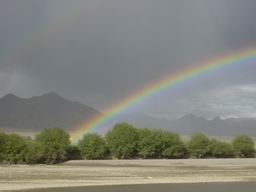 Rainbow landscape |
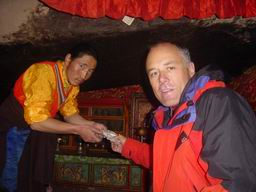 Donation |
 Yaklunch |
 New domestic animal |
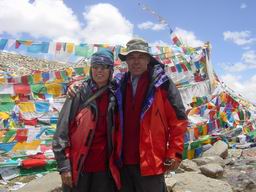 Bergfest |
 Butter dte |
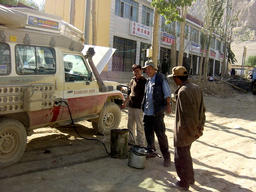 Zanda gas station |
The mountains surrounding us are red, orange, yellow and brown and the rivers and small lakes in the valleys leave thick crusts of salt at the banks. After about three hours we find ourselves on a high plateau at almost 5,000 meters and enjoy the overwhelming view of the canyons and the Indian Himalayas. The River Sutlej has left bizarre formations in the soft sandstone that we will experience close up when we drive the road through this canyon.
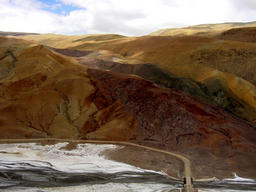 Painted mountains |
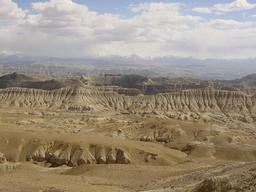 Canyon landscape |
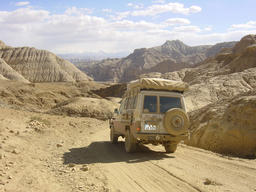 Through the canyon |
The next day we drive to Tsaparang, which lies ten kilometers from Tholing - both ancient centers of the Kingdom of Guge. In the year 10 AD the kingdom was created as many followers of Buddhism fled the borderlands of Tibet to avoid persecution. Ten thousand people lived here up until the 17th century. Today Guge is a ruin on the cliffs. The Summer Palace on the peak of the mountain can be reached through a risky 45-meter long tunnel and to get to the Winter Palace you have to be pulled up by cables. Woe to those who get dizzy. In the temple structures we see for the first time what had been destroyed during the Cultural Revolution. Picture-taking not allowed.
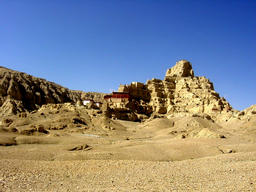 Guge 1 |
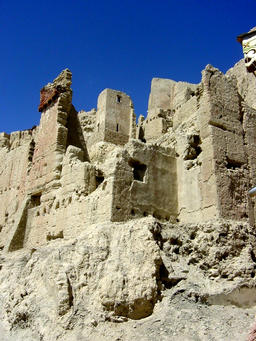 Guge 2 |
 To the Winter Palace |
On our way to Guge „man„ and machine have suffered greatly. Both front bumpers of our vehicle are damaged and the right front spring is broken due to a defect in the material. We are thoroughly disappointed in our OME heavy-duty undercarriage that in only eight months is slowly disintegrating. Tibet, alas, is not Australia. Maybe general importer Taubenreuter will be accommodating.
We are absolutely finished. Our next leg to Ali where we can get our vehicle temporarily repaired can only be done at walking pace. After all, the auxiliary repair job held 300 kilometers.
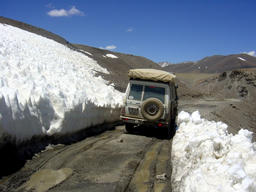 Destination Ali |
OME-undercarriage after 3,000 kilometers of Tibet (MPEG, 270 KB)
We arrived with a stereotypical western view of Tibet: breathtaking scenery, nomads, a deeply religious culture, monasteries, butter lamps, good Tibetans and evil Chinese.
There is no question to the breathtaking scenery that had exceeded our expectations totally with its multifaceted and wide landscapes beyond the Himalayas. We don´t regret one of the 3,000 kilometers that shook us in our land cruiser. Traveling in Tibet is much harder than we thought. The long unstructured road system, the altitudes, the merciless sun, the dry and dusty air, the constant wind and the catastrophic hygienic conditions brought us to the edge or our bodily and emotional abilities. But we wanted it that way!
Contrasting this are the very modern cities that suddenly rise like a „phoenix out of the ashes„ of the desert. Only the best! But it appears that the five-year plan to develop the highway system had been forgotten.
The religious life of the Buddhists found in everyday life fascinated us. With great effort and support from the state, the wounds of the Cultural Revolution are being erased. Many of the monasteries that we visited are still in good condition on the inside as well as on the outside. We were puzzled about the way that the monks recorded all payments for the reading of scripts, the poor not excluded. We felt sometimes as if we were in a bank and not in a monastery. It irked us that they asked for an exorbitant picture-taking fee. Each room costs extra and at a price that would scare away any normal sightseer. In one monastery taking a picture of the kitchen was priced double that of the holiest Buddha statue.
We as individual travelers actually had some problems with the Tibetans. In day-to-day life they are not only very reserved, but also rather unfriendly and not very helpful. Our Tibetan guide often apologized for the behavior of his countrymen. If we got help, it was mostly from Chinese people. It was particularly annoying seeing Tibetans who threw young Chinese people out of their stores. We didn´t experience much tolerance.
But the future can only be accomplished together. Over one third of the total population is Chinese who also see Tibet as their homeland. Many young Tibetans have a Chinese-influenced education and can hardly imagine a Tibet with the old feudal system of the religious State. The old Tibet had never been „Shangri La„ but a very severe State with servants in bondage, social injustice and draconian penalties. The wheels of history cannot simply be turned back. Maybe taking an example of the other sovereign regions of China where minorities under similar conditions have maintained their religious and cultural customs wouldn´t be such a bad idea.
We wish for the Tibetans that they go their way with tolerance within the structure of an increasingly understanding Central Government.
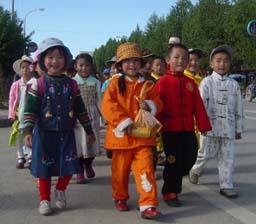 Picture 1 |
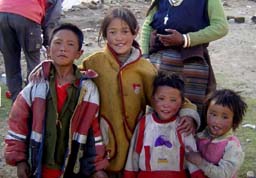 Picture 2 |